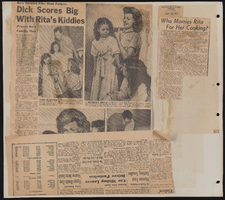Search the Special Collections and Archives Portal
Search Results
Dr. Ruben Acherman oral history interview
Identifier
Abstract
Oral history interview with Ruben Acherman conducted by Monserrath Hernandez and Laurents Bañuelos-Benítez on July 18, 2019 for the Latinx Voices of Southern Nevada Oral History Project. In this interview, Acherman discusses growing up in Palmira, Colombia, where his father emigrated to from Romania. He talks about how accepted he felt in a Catholic community, moving to Cali, Colombia to study medicine, and describes completing his rural residency in San Pedro, Colombia. Acherman then recalls specializing in cardiology at the University of Southern California (USC). Later, Acherman explains why he chose to specialize in cardiology, his interests in pediatric cardiology, and his inability to continue studying due to the lack of financial stability and his immigration status. Acherman describes his move to the Summerlin residential community in Las Vegas, Nevada after being offered a position to work for Dr. Bill Evans in 2001, and compares the differences in health care between the United States and Columbia. Lastly, Acherman discusses his first balloon dilation procedure and talks about the illustrations he has created in cardiology textbooks.
Archival Collection
Glenn Tredwell oral history interviews
Identifier
Abstract
Oral history interviews with Glenn Tredwell conducted by Barbara Tabach on March 04, 2016 and April 14, 2016 for the Southern Nevada Jewish Heritage Project. In the first interview, Tredwell discusses his family ancestry and his Orthodox Judaism upbringing. He talks about his childhood in Atlantic City, New Jersey and describes his family’s Christmas tree farm, potato farm, and wholesale produce business. He talks about his move to Florida, working at Lum’s, a hot dog restaurant, and further explains the company’s franchise success. Tredwell recalls attending the University of Miami, becoming a landscape artist, and moving to Las Vegas, Nevada in 1976. He describes going to dealer school, card dealing at El Cortez and Caesars Palace, and co-founding the Spina Bifida Association of Nevada. In the second interview, Tredwell discusses being the Director of Marketing at Caesars Palace and compares gambling from the 1980s to the 1990s. He talks about his involvement in casino boat operations and his partnership with Millennium Displays. Lastly, Tredwell discusses the progress of his most recent projects.
Archival Collection
Margo Mansergh Papers
Identifier
Abstract
The Margo Mansergh Papers (approximately 1920-2010) document the life of former showgirl and dancer Margaret "Margo" Mansergh Tomaszewski. Materials include photographs of Margo modeling, backstage at various shows, portraits, and personal family photographs as well as programs from her international career performing in the Lido de Paris and Pigalle Nightclub in London, as well as a number of shows in Las Vegas, Nevada, such as Vive Les Girls, Casino de Paris, Minsky's Burlesque, and Lido de Paris at the Stardust. The collection contains materials from Mansergh's modeling career, including photographs, book covers, and images of her as an extra in films. Digital images from the closing Stardust performance and an event for Miss Bluebell are also found in the collection.
Archival Collection
UNLV Libraries Collection on Claes Oldenburg's Flashlight Sculpture
Identifier
Abstract
The UNLV Libraries Collection on Claes Oldenburg's
Archival Collection

Meeting minutes for Consolidated Student Senate University of Nevada, Las Vegas, February 18, 1988
Date
Archival Collection
Description
Text

Transcript of interview with Barbara Agonia by Suzanne Becker, September 17, 2007, September 25, 2010, & October 2, 2007
Date
Archival Collection
Description
When Barbara Agonia arrived in Las Vegas in 1969 to pursue a Master's Degree in English, the University of Nevada Las Vegas was barely ten years old and the population of Las Vegas was just approaching 160,000 residents. At the time, she was 35 years-old and it was a decision and move that would forever change her life and higher education in Clark County. Barbara Agonia was born in St. Louis, Missouri, in 1934 to Robert Lewis Klinefelter and Suzanne Carter Klinefelter. At the time of Barbara's birth, her father worked for Brown Shoe Company in St. Louis. The family moved to Bunker Hill, Illinois when Barbara was still an infant. This was Mr. Klinefelter's hometown where a portion of the extended family still resided. In the late 1930s, Mr. Klinefelter got a job in a brass mill near Alton, Illinois, and he commuted there daily. When the United States entered World War II, Mr. Klinefelter tried to enlist in the army, but was rejected because he had two small children and because he worked in an essential industry. He decided to work in a non-essential industry and took a job at Montgomery Ward in Oak Park, Illinois. Barbara was in the third grade that year. Still unable to enlist, Mr. Klinefelter moved the family to Wabash, Indiana, and began working for General Tire in 1943. They moved to Logansport, Indiana in 1947. Agonia recounts that education has always been a significant part of her life, with the importance of a good education stressed in her life from early childhood forward. After graduating from high school in Logansport, Indiana, she attended Hanover College in southern Indiana, enrolling in 1952. Her educational experience at Hanover included a year studying abroad at the University of Exeter in Devonshire, England—an experience which Agonia credits as further cementing her commitment to education and her love of literature and language. She graduated from Hanover in 1957 with a double major in English and speech/ theater. Agonia spent her first years out of college teaching high school English, speech, and theater in west central Illinois and the next eight in northern Illinois. A little over ten years into her career, at the age of 35, she decided to pursue a Master's degree in English. Her sister, Martha, who at the time lived in Las Vegas, suggested checking into programs offered at the city's newly formed university. In 1969, Barbara moved to Las Vegas and enrolled in the English Department at UNLV. As Agonia was completing her degree in 1971, the community college system in Nevada was emerging and seeking faculty for the up and coming institution. Curious to know more about the new system, Agonia scheduled a meeting with the person in charge of hiring. Two hours later, she walked out with a contract in her hand, one of eight new faculty members at Clark County Community College, now known as College of Southern Nevada. In her early years with the college, Agonia did a great deal of public speaking on behalf on the newly formed system, promoting the new institution and reaching out to potential students. At the same time, she taught full course loads in composition and literature, and eventually became chair of the English department. Her new position and public speaking work on behalf of the college not only provided her contact with the local Las Vegas community, it ultimately became the catalyst in spurring her passion for community involvement, particularly working on behalf of women within the community. • • Vll As the 1980s approached, Agonia became actively involved in rape crisis education, at the urging of Florence McClure. Then, in 1980, Agonia was again in on the ground floor of community programming, when she and Beverly Funk, at the urging of Judith Eaton, the president of Clark County Community College, established a Women's Center on campus. The Center was initially set up to help women in a variety of life circumstances, including women who were wanting to return to school or who were new to the process of school altogether. The center eventually became the Re-Entry Center offering skill development, tutoring programs, and other forms of assistance for anyone interested in returning to school. In addition to her involvement in and commitment to public education, Agonia has also been involved in the Soroptimist International organization for business and professional women who work to improve the lives of women and girls in local and international communities. In the Las Vegas area, Soroptimist International of Greater Las Vegas worked to establish the Rape Crisis Center and the Center for Domestic Violence, which later became SafeNest. Agonia has been working with the organization since 1982. Through Soroptimist International, she also became involved in Friends of the Nevada Wilderness, an organization devoted to designation and long-term protection of Nevada's wilderness areas. As the representative for Soroptimist International, she traveled to Washington to lobby and testify in front of the senate for the establishment of Great Basin National Park. Agonia's work in the Las Vegas community over the past forty years has been significant. She counts Florence McClure, Geneva Douglas, and Jean Ford amongst her greatest influences. As she notes in her oral history, "I learned how to be radical from those women." She happily embraces the label of radical. This attitude surfaces throughout Agonia's experiences and recollections, and underscores her work and dedication to the interplay of local education and women's issues within Nevada.
Text
Stella Champo Iaconis Photograph Collection
Identifier
Abstract
The Stella Champo Iaconis Photograph Collection (approximately 1890-1950) contains four black-and-white photographic prints of the Helldorado Days celebration held in Las Vegas, Nevada and three photograph albums with family photographs. Included in the albums are images of Italian family members, and Stella and her sister Irene as young children on their family ranch in Southern Nevada in the 1920s and 1930s. The Champo family and other Las Vegas residents are prominently featured in photographs taken across Las Vegas, including at the Boulder Dam (Hoover Dam) dedication, the family's farm, and outside residences near downtown Las Vegas. The third album covers Stella Champo's personal life, with photographs of her first husband, Walter Cordano (married 1934-1942) and her second husband, John Iaconis. Included are trips to Los Angeles, California; Pioche, Ruth, and Goldfield, Nevada; and early downtown Las Vegas, including the Union Pacific Station. A partial inventory is available for the third album.
Archival Collection


